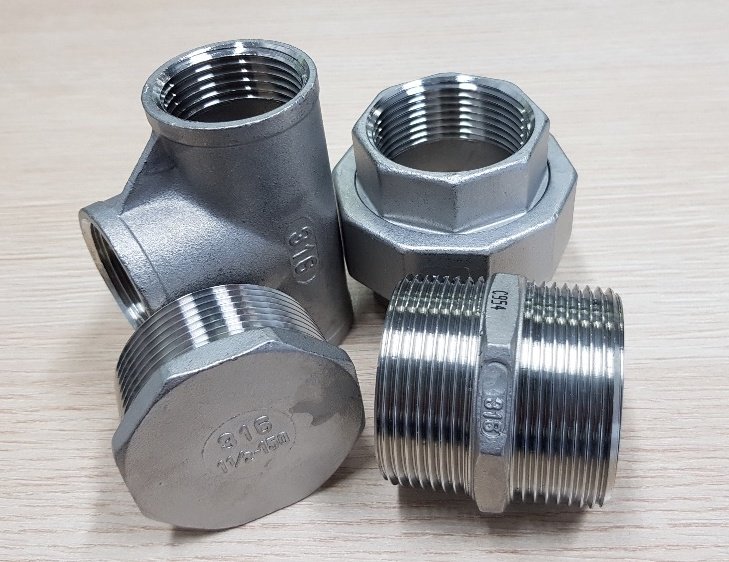What is the difference between Grade 304 and Grade 316?
By Chris Waltos
304 vs 316: And the broader 300 series alloy family
It is estimated that around half of all Stainless-steel usage globally is down to two alloys: 304 and 316. These ubiquitous grades are those people think of first when talking Stainless steels. “18-8” and “marine grade” are commonly heard in general public, and for good reason. Versatile, aesthetic, easily workable and sourced, and providing a wonderful mix of corrosion resistance and physical properties, their use is seen across many applications.
But what are the technical and practical differences between them? And why choose one over the other? Answers to these questions, and a brief summary of grades similar to 304 and 316 will be the focus of this blog.
304: The entry point
Steels are considered to become Stainless when at least 10.5% Chromium is added, such that a passive surface film becomes stable enough to protect the material from further oxidation. These most basic grades are ferritic in form (think 410 grade) and while useful, the ferritic form does have some limitations.
Adding enough nickel (approx. 8%) to the mix, such that the alloy becomes austenitic, changes the properties to make it more weldable, formable and tougher. Keep carbon low (for L grades <0.02%), a little manganese for hot ductility (useful during production) and to aid austenite stability, a smidge of Nitrogen (great for strength, pitting corrosion resistance), and we now have 304.
As a baseline, 304 provides good resistance to weak oxidising acids, low levels of aqueous chlorides (salty water) and alkali solutions, generally at ambient to low temperatures.
316: A worthy upgrade
Taking our 304 alloy, we can significantly improve corrosion resistance (particularly against pitting and crevice corrosion in chloride bearing environments) through adding around 2% Molybdenum. We must also add a little more Nickel to keep our austenitic microstructure, and we now have 316 – the most widely used stainless alloy.
In contact with water, the chloride content of the water has a huge bearing on whether the metal will resist pitting and crevice corrosion, along with temperature. Assuming ambient water (generally 20-25 degrees C) and neutral pH, an approximate guideline on permissible limits are 200ppm for 304 and 1000ppm for 316, as published by the Nickel Institute. Note these are significantly lower than the chloride content of seawater, roughly 35000ppm! So be careful when using ‘marine grade’ 316 – a bit of a misnomer – on the coast. Seek specialist advice.
Are there any trade-offs to going with 316? No major ones, apart from cost due to the difference in alloying. 304 tends to perform a little better with oxidising acids, and cold works a little differently. Availability in product form is similar, with 316 being slightly more available in breadth.
Lesser-known alternatives
Because of the genuinely amazing versatility of austenitic Stainless steels, variants which focus on optimising one particular property are prevalent.
304H and 316H are higher carbon versions (the “H” denotes carbon content of between 0.04-0.1% versus a maximum of 0.03% for “L” grades). These have higher strength and creep strength at temperatures above 500 degrees C and as such are used in high temperature applications, however they can easily be sensitised (become susceptible to intergranular corrosion if exposed to temperatures between 450-850 degrees C). They are not readily stocked.
321 and 347 are basically ‘stabilised’ versions where Titanium and Niobium respectively are added to prevent sensitisation. These also have “H” versions available, and their continued use stems from being popular alloys when many legacy chemical plants and refineries were built in the mid last century. Stirlings continues to stock 321 in various product forms.
Grade 310 (and the even less common 309 version) is used for high temperature applications, giving better performance than the H grades due to higher chromium and much higher nickel content. 253MA, a further development with some special alloying additions, provides even better high temperature performance in most cases and is a readily stocked cost-effective alternative.
There are even more derivatives possible; 303 for improved machining, 317 for slightly better corrosion resistance than 316, 301 for work hardening optimisation…
Conclusion
For most applications however, the standard 304 and 316 perform wonderfully. Stirlings are happy to advise on grade suitability and talk through the best option for your application.
How do I tell the difference?
I’ve lost my test certs and the metal is not marked with any heat number – how do I know which I have? Visually, you can’t. But there are a few ways to find out. A molybdenum drop test will confirm, or even better, Positive Material identification is possible using a portable XRF device. Stirlings has one available and can assist.
A rhyme for your time
Grade 316 is Grade 304 with some added Moly, if it’s increased corrosion resistance you need – put some sixteen in your trolley!

